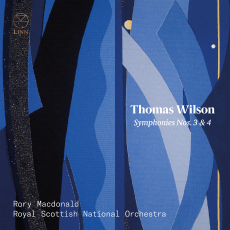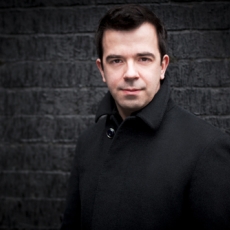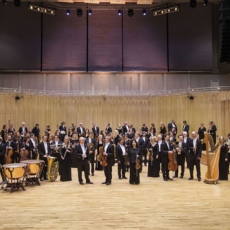Rory Macdonald & RSNO - Thomas Wilson: Symphonies Nos. 3 & 4 - The Art Music Lounge
British composer Thomas Wilson, born in the small mining town of Trinidad, Colorado in 1927, studied at both St. Mary’s College in Aberdeen and, after World War II, at the University of Glasgow. He later taught music at the University of Glasgow and a fellow at the Royal Society in Edinburgh. Somehow, then, this American-born musician was later dubbed “The Father of Scottish Music.” His Third Symphony was written in 1979 and his Fourth in 1988. He was famous for saying that “for me, music does not simply describe, it must EXPLORE!”
This disc reverses the order of the symphonies, presenting No. 4 first. It opens with an upbeat bitonal fanfare for brass, strings and chimes, which he then almost immediately begins to expand upon. The body of strings enters as a support, and one hears other percussion instruments enter the fray: piano, glockenspiel, triangle etc. Indeed, the piano part even peeps out from behind this aggregate of sound for a brief two-bar solo before the strings, now playing a slower, more lyrical theme, take the music in an entirely different direction. One thing that struck me was that his music, to my ears, really didn’t sound like anyone else’s except in his adherence to a logical structure in development. He apparently liked very clear, transparent textures, considerably different from the usual symphonic composer, using a full orchestra almost like a chamber orchestra. There are absolutely no thick textures in his music; all was clarity and lucidity. This description may cause some readers to think that he based his aesthetic on the French composers like Debussy, but there’s nothing French-sounding about his music. There are allusions here to Stravinsky, Berg, Bartók and even a smidgen of Roy Harris, yet it doesn’t really sound like any of those composers. Even when the music opened up into brisk, dramatic sections, Wilson kept his sonorities clear and open, almost like an organist who only used the brightest stops.
And his musical imagination was very keen indeed. As the movement progresses and develops further, he keeps you on the edge of your seat, wondering what will come next. Performed in one unbroken movement over nearly a half hour with individual sections, one’s attention never lags, and Wilson was not one to waste the listener’s time with superfluous or repeated phrases. Indeed, the tightness of his writing was another of his great strengths. There are no superfluous moments or flashy “dramatic gestures” in his music. If it didn’t contribute to the whole and didn’t “explore,” he simply didn’t write it in. The only repeated theme or motif is the opening of the symphony, which is quoted again towards the end as a means of completing the circle.
The Third Symphony, from 1979, is cut from the same cloth but in a different pattern. Soft, rumbling timpani introduce equally soft, menacing sounds from piano and low strings and brass. Violas scamper in a whining atonal pattern, working themselves upward in pitch while what sounds like bongo drums play in the background. The swirling atonal string figures now work their way up into the violins and become louder before a punctuated series of brass and wind chords, then the volume recedes once again as clarinets and oboes play an amorphous theme which is then worked upon. Once again, Wilson crafted a clear, transparent score that sounds as if it were using far less instruments than that of a full symphony orchestra, but that power is always in reserve. Eventually the tempo increases as we hear a series of scampering figures played in snatches by the strings, percussion and woodwinds, alternating with slow sections that suggest mystery. The piano gets an even longer solo here than in the Fourth Symphony, a sort of atonal jig that spurs the development section. And once again, the listener is caught by surprise as the music takes unexpected twists and turns, including a particularly strange passage in which a solo clarinet is heard playing long, repeated A’s. It’s the kind of moment that somehow sticks in your mind, which is probably what Wilson intended. He later repeats this as another bridge passage, just as he later still uses his ominous but syncopated rhythm a springboard for further development. He also builds up a dramatic series of transition chords which lead a (for him) quite unusual explosion from the full orchestra. Eventually it develops into a clearing of soft, simple chords, a bit reminiscent of Copland. This is absolutely wonderful music!
The final work, Carillon, opens with a medium-slow but very dramatic fanfare in an E minor mode, which is then worked out with development and contrasting ideas. This piece was written to celebrate Glasgow and “the enduring spirit and resilience of its people,” although Wilson made it clear that his music never was “Scottish” in a very specific ethnic sense. Yet even in this celebratory piece, written on commission, Wilson did not cheapen his art to produce an “easy” or populist piece. He still followed his own muse, and in fact Carillon may be the tightest-written work of the three presented here. It is certainly the most consistently dramatic in feeling, despite the quiet but uptempo middle section in which piano, harp, low strings and a little percussion interact, or the ensuing quiet passage for celesta, harp, low strings and muted trumpets. And, once again, Wilson takes the music in directions you simply don’t expect or cannot predict. A loud, dramatic flourish ends it.
For someone like me, who was unfamiliar with Wilson and his work, this CD will be a revelation, and a very good one at that.


